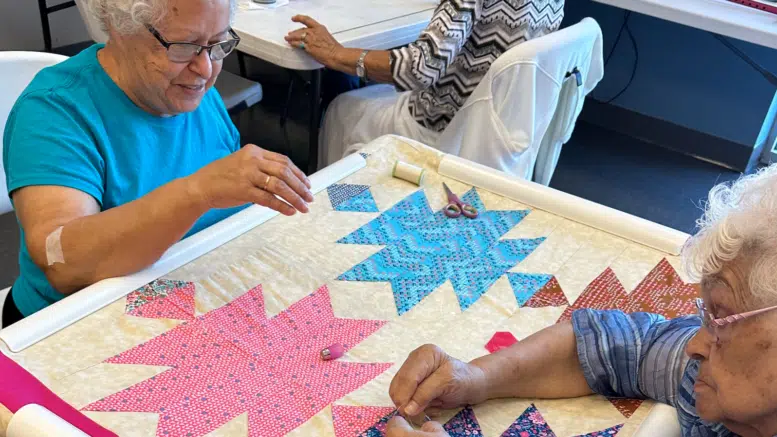By Thomas Goldsmith
Enduring threads of North Carolina’s past — such as bygone industries and separate public schools for whites, Blacks and Native Americans — still affect older state residents, as harmful holdovers and even, in some cases, as positive forces.
Interviews with residents of small counties showed that the forces affecting the lives of North Carolina’s 1.8 million residents who are 65 and older often date to decades past.
The interviews were conducted as budget writers at the state General Assembly seemed to ignore calls to boost funding for lower-profile — but vital — agencies such as NC Adult Protective Services. Instead, lawmakers focused on proposals that would cut personal and business income taxes and increase support for private-school vouchers that would cost nearly $500 million annually by 2030.
Meanwhile, older residents in Robeson County recalled the experience of learning in separate public school systems for white, Black and Native American students.
“We were not furnished books,” Geraldine Lowry, 78, said of her primary education in schools attended by Lumbee students under the divided county system.
“They wouldn’t let us have a lot of books, and, when they came, they were the ones that the other schools would throw away,” she said.
Lowry was talking with members of the Lumbee Elders women’s group that meets regularly in the Pembroke headquarters of North Carolina’s Lumbee tribe, who number about 55,000 people in Hoke, Robeson, Scotland and Cumberland counties.
“We did the best we could with what we had,” she added.
Making do
As illustration, Lowry recalled the way Lumbee and Black children learned to play baseball with a rock wrapped in tobacco twine.
After seeing tribe members save up to help the schools stock books and supplies as she learned, Lowry went to college and enjoyed a long career as a Robeson County teacher. She’s seen her own children and grandchildren head off to colleges that would have been closed to her as a high school senior.
Lumbee Elders member Earlena Lowery, 80, also graduated from Robeson County’s Normal schools for Lumbee students, then moved on to earn master’s and doctoral degrees — far from home, she said.
“The mentors, the older teachers with experience, their recommendations were: ‘To the West, go to schools in the West,’” she said in August during a telephone follow-up to the Lumbee Elders gathering.
“Not your East Carolinas and those other schools. No, it was Appalachian, Western Carolina or Peabody [Vanderbilt University’s school of education]. You couldn’t go to those other [North Carolina] colleges because of who you were.”
Have the Lumbee people who were students of the segregated decades before the 1970s, felt disadvantaged by the experience as the years have worn on?
Perhaps, but not necessarily, Lowery said. She recalled dedicated teachers, saying that many among her peers have gone on to successful careers in business, education and the ministry.
“It’s just like today,” she said. “You’ve got barriers, and you’ve got to be strong enough to work through them. There were probably students that, I won’t say were held back, but students who didn’t work through the barriers like some of us do.”
Life without a diploma
Today, almost a quarter (23.6 percent) of Robeson County adults over the age of 25 lack a high school diploma, compared with the state average of 13.7 percent who did not complete high school. The county also lags when it comes to higher education, with only 12.6 percent of adults over 25 holding bachelor’s degrees, compared with a state rate of 29 percent.
Mary Locklear, another attendee at the Elders meeting, said only one word, “Proud!” when asked her feelings about growing up as a member of the Lumbee tribe. But her life’s choices were limited, she said, when she left the schools segregated by ethnic background before 10th grade to labor alongside her family on a tenant farm.
“We had to work,” Locklear said. ”We worked on this other man’s farm. It was seven of us, working in tobacco, cotton, cucumbers — you name it — hoeing tobacco and all that good stuff.”
Another barrier, she said, was her father’s failure to provide for the large family. “I never knew my daddy to work,” Locklear said. “He run the road and [was] drunk all the time.
“I never seen him cut a piece of wood to keep us young’uns warm nor nothin’. We had to do it.”
Alcohol misuse continues to be an issue in Robeson County. Between 2009 and 2021, the data show, more than 900 deaths of North Carolina residents in Robeson were listed as attributable to alcohol, which works out to a per capita rate that is much higher than in larger counties such as Wake, Mecklenburg and New Hanover. In 2021, Robeson County had a alcohol death rate of 105 per 100,000 population. Only two other counties in the state — Jones and Pamlico — had higher rates.
Buffeted by global winds of change
Changes detectable for decades can arise through international trade developments and by decisions of state departments from the Division of Health and Human Services to the Marine Fisheries Commission.
Robeson and Hertford counties have felt the impact of departing plants and companies that had been mainstays of employment in communities, said E. Frank Stephenson, 83, a Hertford County resident, historian and former Chowan University official. Stephenson has chronicled instances such as the collapse of the herring fisheries that were central to northeastern North Carolina, in part through decisions by the state.
The state herring trade reached a peak of 20 million pounds in 1969, but it dwindled first because of foreign competition for the bony fish, then because of overfishing and the fisheries commission’s efforts to manage the catch. The community events, extra income and household barrels of salted herring have become endangered species.

Credit: Thomas Goldsmith
“People depended on herring fishing for food,” Stephenson said. “During the spring when the herring came up here, people would catch them and salt them down. That was to have them just in case during the year you had a bad crop year in a rural area.”
Another business development that hurt the incomes and community of lower-income residents came with the shutdowns in 1970 of large Hertford County factories devoted to making baskets of gum-tree wood. Stephenson called the basket-making Riverside Manufacturing Company a “lifeblood” for its hundreds of employees. His daughter Caroline Stephenson, 52, runs a local nonprofit and has worked with Frank Stephenson on his books.
“It really got bigger and up and running in the ’30s and ’40s after the war,” Caroline Stephenson said of Riverside Manufacturing during a joint interview in Murfreesboro. “It enabled a lot of African Americans to basically stop sharecropping and move into town and to become homeowners.
“It created this, I wouldn’t say Black middle class, but it certainly got people off of the farm and away from dire, extreme poverty — which is sharecropping.”
Leaving, only to return
Another way out has involved simply leaving home and extended family, a route chosen by Rosa McMillan, 64, a project analyst who retired from New York City’s famed Memorial Sloan Kettering Cancer Center and recently returned to Hertford County. At the Murfreesboro Nutrition Center, she reminisced about working as a sharecropper from the late ’60s to the early ’70s while living with her grandmother after the deaths of her mother, father and great-grandmother.
“We grew up on a dirt road,” she said. “I worked in the fields from the time I was eight until I was 16 — tobacco fields, cotton fields, cornfields. We was up in the morning, and we was on the back of somebody’s truck going to their fields.”
Sign up for our Newsletter
“*” indicates required fields
But that wasn’t all it took to keep the household going, as McMillan’s grandmother raised and dealt in pigs, chickens and bootleg whiskey.
“My grandmother sold liquor here in Hertford County. That’s how we was raised,” McMillan said.
People visited the large farmhouse with no air conditioning in summer or heat in the winter every day of the week to have a drink and listen to soul-music performers such as James Brown and Marvin Gaye on a jukebox that was called a piccolo for its small size.
McMillan recalled: “They came and said, ‘Miss Mary, could I have a pint?’ ‘Miss Mary, could I have a shot?’ and they’d get a shot and they’d sit there drinking.”
McMillan left Hertford County as soon as she could, but she still values what she learned in the big house set back from a dirt road.
“We went to school in the morning and came home at night,” McMillan said. “It was a hard life, but it was a good life. [My grandmother] told us that if you want something you’re going to have to work for it, because nobody’s gonna give it to you.”
Older people like McMillan and Berna Stephens, who have enjoyed success after years as working professionals in other states, still deal with remnants of old stresses and biases now that they’ve returned to Hertford County.
After years working with the U.S. Census Bureau near Baltimore, Maryland, Stephens, 76, serves as a town council member in Murfreesboro. She sometimes deals with screeds from people who move out to avoid paying property taxes within town borders.
But with a family reunion coming up, she’s been visited by memories of an incident that touched her deeply even though it happened in the ’30s, before she was born.
Her maternal grandfather had lent money to a church fund, putting up his farm as surety.
But, according to Stephens’ family lore, fellow parishioners didn’t follow up on their promises to pitch in on loan payments, so her grandfather lost the farm, with no help or understanding from an all-white legal establishment, she said.
North Carolina had more than 12,000 Black operators of entire farms in 1930 and more than 900 “Indian” operators in the same year, according to the U.S. Department of Agriculture’s Census of Agriculture Historical Archive, Black farmers once operated 25 percent of the state’s farms; that share had dropped to three percent as of 2017. The most recent Census of Agriculture report showed that Black operators in Hertford County owned nine farms. In Robeson, the number was 42.
There’s no way to calculate how much the loss of each farm cost the displaced owners in family wealth, self-esteem or future prospects.
“You think you get over things until that subject comes up again and you think about the effect it may have had,” Stephens said.
A lack of money for transportation, which better-off families could have provided, meant that one of Stephens’ aunts had to bypass an early road to what her family believed would be better prospects.
“She was 16, and that probably kept her from going to college,” she said. “She had a scholarship, but she couldn’t go.”











